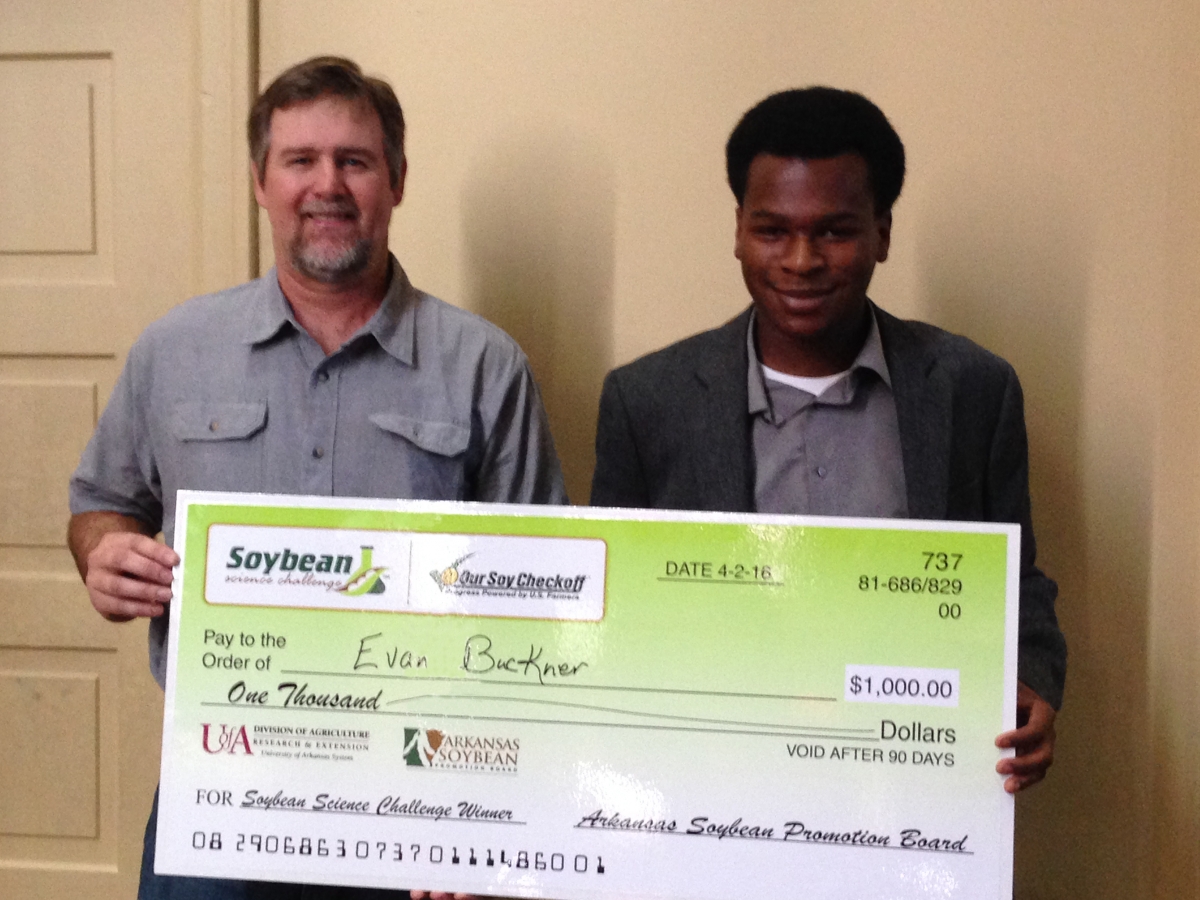Evan Buckner

Evan Buckner wins Southeast Arkansas Regional and Southwestern Arkansas State Science and Engineering Fairs Soybean Science Challenge Award
Evan Buckner ,16, a junior at Pine Bluff High School won the Southeast Arkansas Regional Soybean Science Challenge and the Southwestern Arkansas State Science and Engineering Fair Challenge held at the University of Central Arkansas on April 1-2. Evan was also the first Soybean Science Challenge winner in the Southeast region in 2015.
Buckner received a $300 cash award at the regional level and a $1,000 award at the state level provided by the Arkansas Soybean Promotion Board. Both prizes were provided by the Arkansas Soybean Promotion Board. Buckner’s science project was based on his 2015 original research testing two different soybean strains to see which one would be more effective in fighting a common plant pathogen. His 2016 science project, “Fighting Pythium aphidnerdermatum in Soybeans: Part II” tested three chemical fungicides to see which one would show the most resistance to the plant pathogen.
Buckner did part of his research with Dr. Sathish Ponniah and Dr. Muthasamy Manoharan in the Department of Agriculture at the University of Arkansas at Pine Bluff under the direction of Dr. Manoharan, a plant scientist.
Buckner’s completion of the online Soybean Science Challenge course made his project eligible for competition at the regional and state fairs. The part of the online course that helped Buckner was “the section which talked about the hundreds of farmers in Arkansas that depend on soybeans in their everyday lives,” he said.
Buckner said he was really overwhelmed and truly thankful for both awards. “When I heard my name called I nearly ran down the aisle forgetting that I was on crutches from a soccer injury. I didn’t actually realize I had won the Southeast Arkansas Regional award until I returned to my seat and read through everything. I broke into a wide grin.” Since taking the Soybean Science Challenge online course, Buckner said he now understood the real economic and agricultural impact that comes from soybeans. “It’s truly amazing how this one seed can be used in such things as biofuel to tofu,” he said. “It’s a seed that will take us into the future.”
Buckner’s parents, Drs. Anissa and Edmund Buckner, said they “were surprised at first, but knew he deserved it. Evan’s hard work and interests in plant science are paying off.” His mother said the recognition of his project was encouraging Buckner to study and work harder both academically and scientifically.
Buckner first started a garden club in junior high school and has initiated a Garden Club at his high school with different plants and flowers. He now takes care of the plot in between classes at school and on some weekends. Buckner and his assistant principal wrote a small community grant to help fund the plot. Faculty at Pine Bluff High School assist in sponsoring the club and provide materials, insight and do hands-on work with Buckner.
Buckner has a variety of interests and talents beyond his soybean research and general focus on the plant sciences. He enjoys playing the viola in his high school orchestra as well as the Arkansas Symphony Youth Orchestra. He is a Boy Scout and on his high school soccer team.
On Buckner’s horizon for next year is more extensive work with soybeans, including field studies of the plant and other potential pathogens. He plans to compete again in the Southeast Arkansas Regional Science Fair and again at the state fair level if eligible.
“The Soybean Science Challenge has changed my outlook on plant science,” Buckner said. “I learned more in the Soybean Science Challenge course than I could in any classroom or textbook.”
“The Arkansas Soybean Science Challenge Award program is in its third year partnership between the UofA Cooperative Extension Service and the Arkansas Soybean Promotion Board,” said Dr. Karen Ballard, Extension developer and director of the program.
“The goal of the Arkansas Soybean Science Challenge is to engage students in ‘real world’ education to support soybean production and agricultural sustainability,” said Shannon Davis, past president of the Arkansas Soybean Promotion Board. “The program also rewards scientific inquiry and discovery that supports the Arkansas soybean industry.”
The Arkansas Soybean Science Challenge was opened in January 2014 to 9-12 grade science students. Students who successfully completed the online course were eligible to have their original soybean-related research projects judged at the 2016 ISEF affiliated Arkansas science and engineering fairs.
Information on the 2016-2017 Arkansas Soybean Science Challenge will be available in summer 2016. For more information, contact Dr. Karen Ballard at 501.671.2086 or kballard@uaex.edu.
The Cooperative Extension Service is part of the University of Arkansas System Division of Agriculture.
Evan Buckner–Arkansas Soybean Science Challenge Regional Winner –Southeast Arkansas Regional Science Fair and Southwestern Arkansas Energy State Science & Engineering Fair
Project Title: Fighting Pythium aphidnerdermatum in Soybeans: Part II
Abstract: The purpose of this experiment was to see which out of the three chemical fungicides: Thiram, Metalaxyl, and Pyraciostrobin, would show the most resistance to the plant pathogen Pythium aphanidermatum. The experiment involved four separate groups of each chemical group and 1 for control for each chemical fungicide. There were 10 seeds to each group for a total of 480 seeds for the three replications ran over a period of 1 week for all three replications. The hypothesis stated that Pyrociostrobin and Thiram would be the chemical fungicides with the highest resistance second to Metalaxlyl. Of the three replications ran throughout the course of the experiment, they showed the average healthy seeds in the control group as 2.0, average healthy seeds for Thiram 2.6, Pyraclostrobin 3.6 and Metalaxyl with 5.7. Though my original hypothesis was proved wrong it is still beneficial to have findings that Pyroclostrobin came second to Metalaxyl and directly under Pyraclostrobin was that of Thiram.

Left to right: Arkansas Soybean Promotion Board Member Joe Thrash with Evan Buckner
